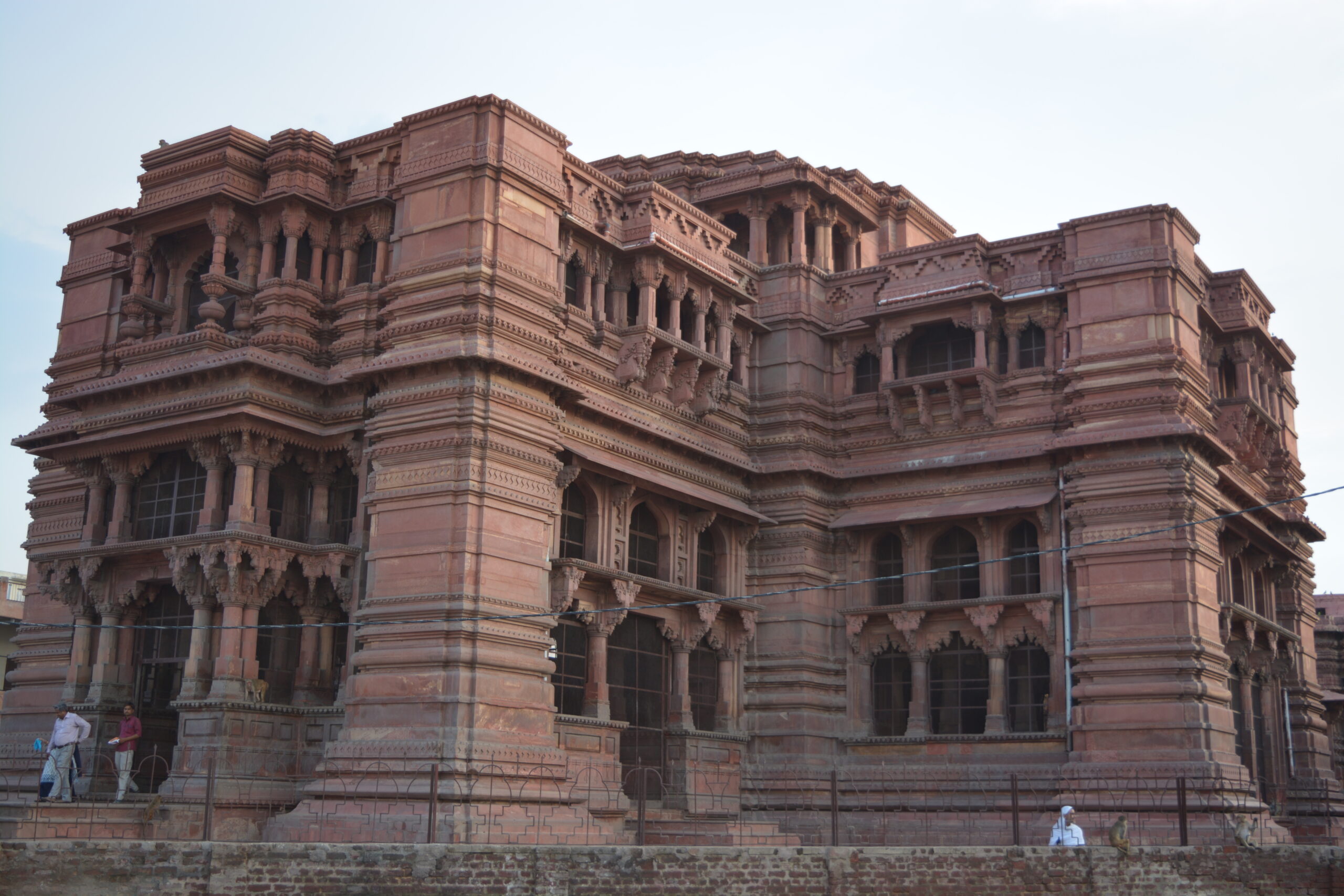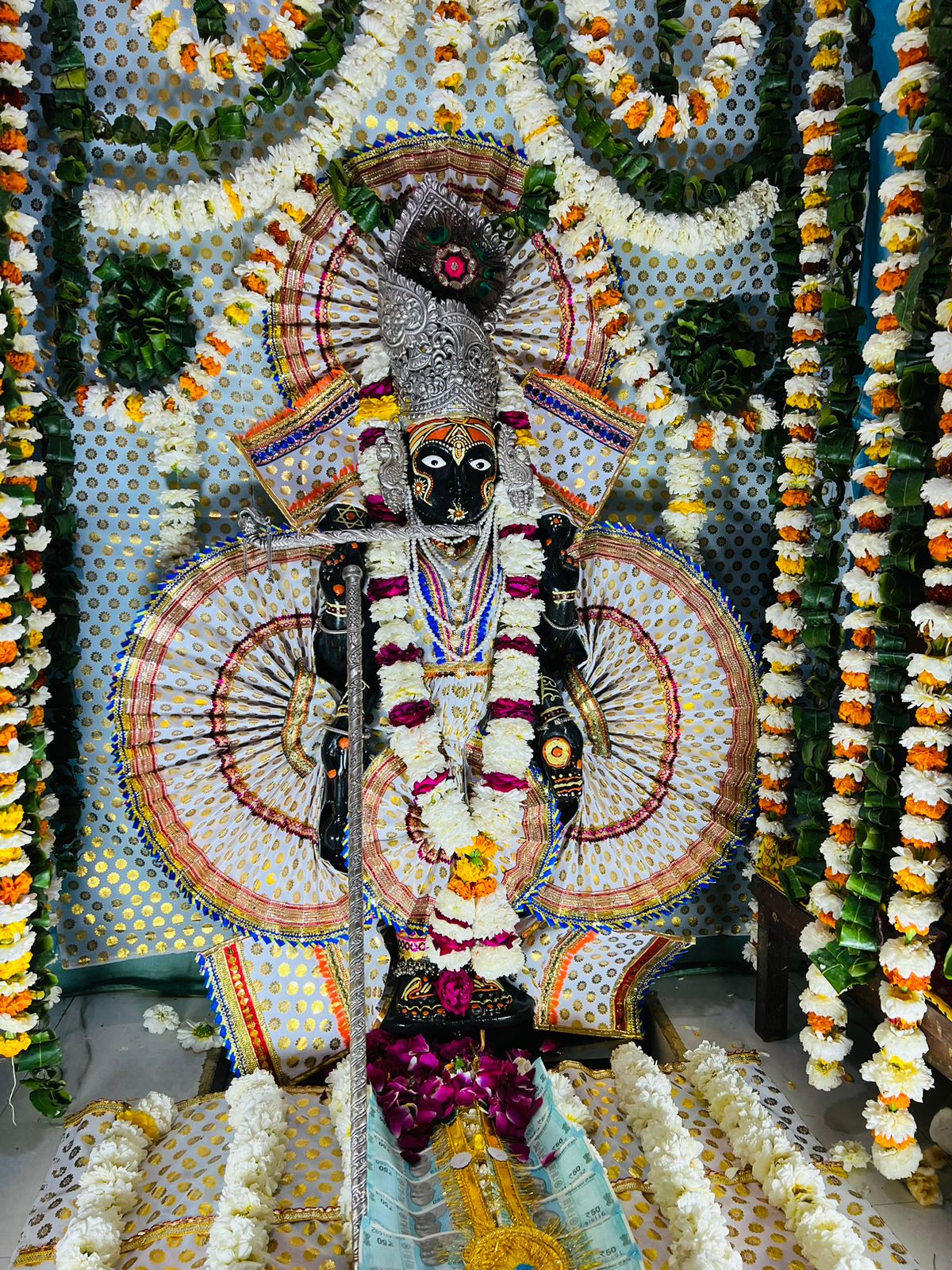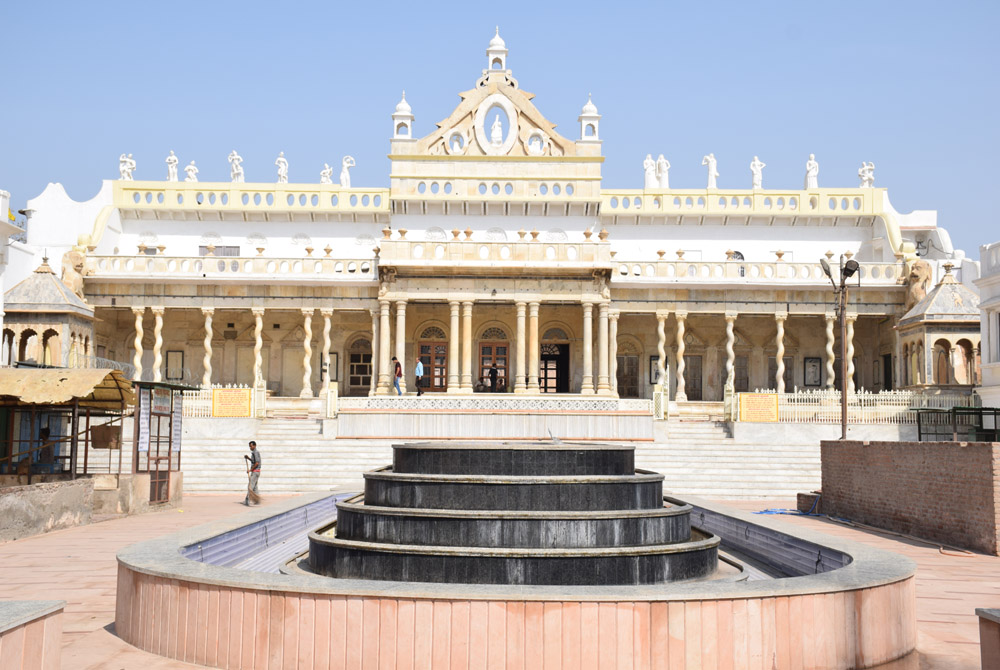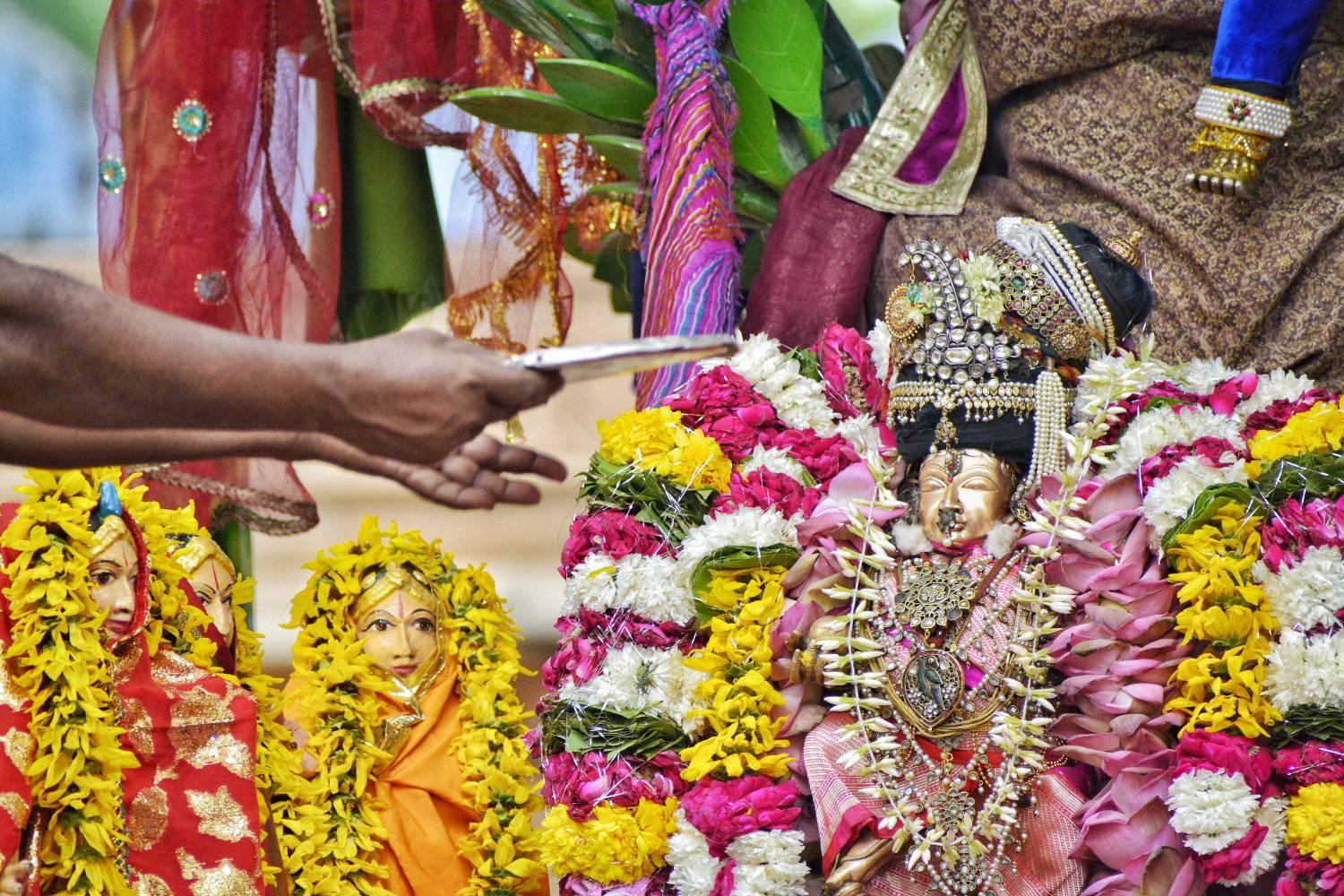By Ashee Sharma
I remember Shri Shri Radha Govind who are sitting on a gem-studded throne, and enjoying the loving services of Their most dear sakhis Shri Lalita and Vishakha, in Their glittering abode, under the Kalpvruksha that blossoms in the ever-enchanting forest of Vrindavan…
दीव्यद्-वृन्दारण्य-कल्पद्रुमाधः श्रीमद्रत्नागार-सिंहासनस्थौ।
श्रीश्रीराधा-श्रीलगोविन्द-देवौ प्रेष्ठालीभिः सेव्यमानौ
The search for the King of Vrindavan: Govind Dev
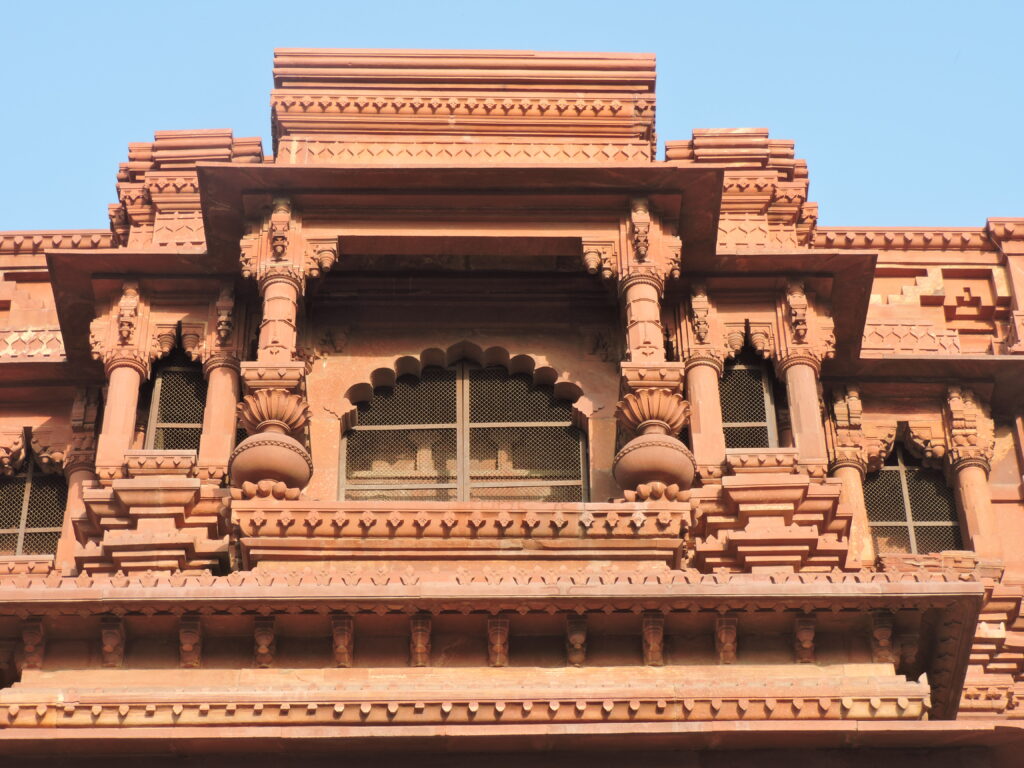
Shri Krishna’s great grandson, Vajranabh is said to have made eight ‘vigrahas’ in Braj – four Dev (Hardev, Baldev, Keshav Dev, Govind Dev), two Nath (Shrinath, Gopinath) and two Gopal (Sakshi Gopal and Madan Gopal)…
चारि देव, दुई नाथ, दुई गोपाल बाखान।
बज्रनाभ प्रकटित एइ आठ मूर्ति जान।।
Shastras have clearly indicated their features, whereabouts, glories and seva. It was based on such revelations that Shri Chaitanya Mahaprabhu instructed Rupa Goswami to set out on the search for these lost treasures of Braj.
While looking for Govind, Rupa Goswami wandered in the forests, gardens, and villages of Braj-Vrindavan asking people about the exact location of the Yogapeetha where He resides, but no one had an answer. Disappointed, he sat on the banks of Yanuma one day and began to ponder, “Who has the ability to find Him. Like the sun, He must reveal Himself.” He cried, Oh Govind, Oh Govind, as tears kept flowing from his eyes.
As he sat lamenting, an unusually attractive Brajwasi approached him and on learning the reason behind his grief said, “Near Keshi Tirth, is a sacred place called Gomatila. That is the Govind/YogPeeth you are looking for. A cow comes there every morning to feeds Govind with the milk flowing from her udder. I shall take you there.” On reaching Gomatila, the Brajwasi disappeared. Rupa Goswami at once understood His identity as the supreme Lord and fainted in ecstasy.
On gaining consciousness, he gathered some Brajwasis to excavate the site that lay wet with the cow’s milk. Soon the radiant form of Govind emerged and everyone was overjoyed. The Lord of Vrindavan had been found. The year was 1536, though some accounts say it was as early as 1525.
पुनर्वृन्दावने चैव वृन्दादेवी प्रसादत:।
वृन्दादेवी प्रसक्ताय पूर्ण कामस्य हेतवे।।
हृषीकेशो करोद्रूपं नाम्ना गोविन्द संस्थितः।
चतुर्दशसमावस्थः अवतारो विराजते।।
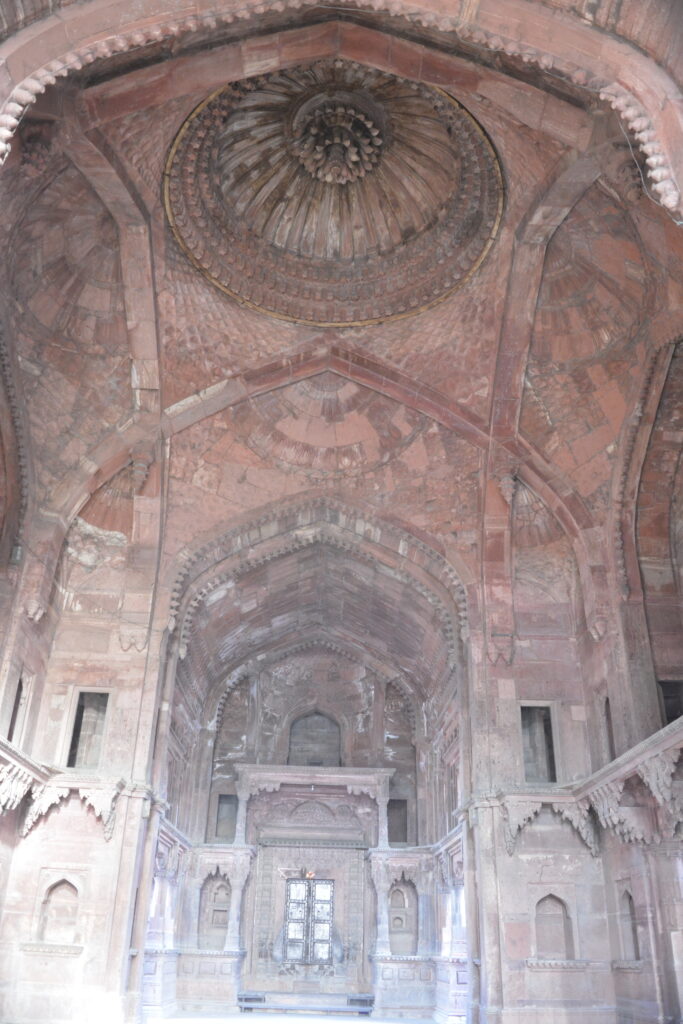
(ब्रह्म वैवर्त पुराण)
By the grace of Vrinda Devi, Shri Bhagwan appears as the all-powerful and wish-fulfilling Govind. He resides in Vrindavan in His form as a 14-year-old (nava kisora).
Rupa Goswami quoted the shastras to establish that Gomatila was indeed the Dwapar Yuga Yogpeetha mentioned therein and the unearthed vigraha was the one made and worshipped by Shri Vajranabh at this place.
He then wrote a letter to Shri Chaitanya Mahaprabhu in Puri informing Him about Govind’s appearance. Mahaprabhu was delighted. He ordered His disciple Kashishwar to leave for Vrindavan at once. Kashishwar agreed, albeit reluctantly, because he could not bear separation from his master. Understanding his dilemma, Mahaprabhu gave him His Gaur-Govind murti and said, “Know that Gaur-Govind and I are one. I will always be with you in this form.”
On reaching Vrindavan, Kashishwar established the Gaur-Govind vigraha near Govind Dev and started worshipping Him.
काशीश्ववर अन्तर बूझिया गौरहरि।
दिलेन निज-स्वरूप-विग्रह यत्न करि।।
प्रभु से विग्रह सह अन्नदि भुज्जिल।
देखि काशीश्वरेर परमानन्द हैल।।
श्रीगौर गोविन्द-नाम प्रभु जानाइला।
ताँरे लैया काशीश्वर वृन्दावने आइला।।
गोविन्द दक्षिणे प्रभुरे बसाइया।
करये अद्भुत सेवा प्रेमाविष्ट हैया।। (भक्तिरत्नाकर)
According to Chaitanya Charitamrita, one of Shri Raghunath Bhatta Goswami’s disciples got a temple built for Govind Deva and offered gems, and jewelled trinkets at the Lord’s feet. By some accounts, this disciple was Maan Singh’s father, Bhagwant Singh and the first temple came up in samvat 1561.
PART – I
From Govind to Shri Shri Radha Govind
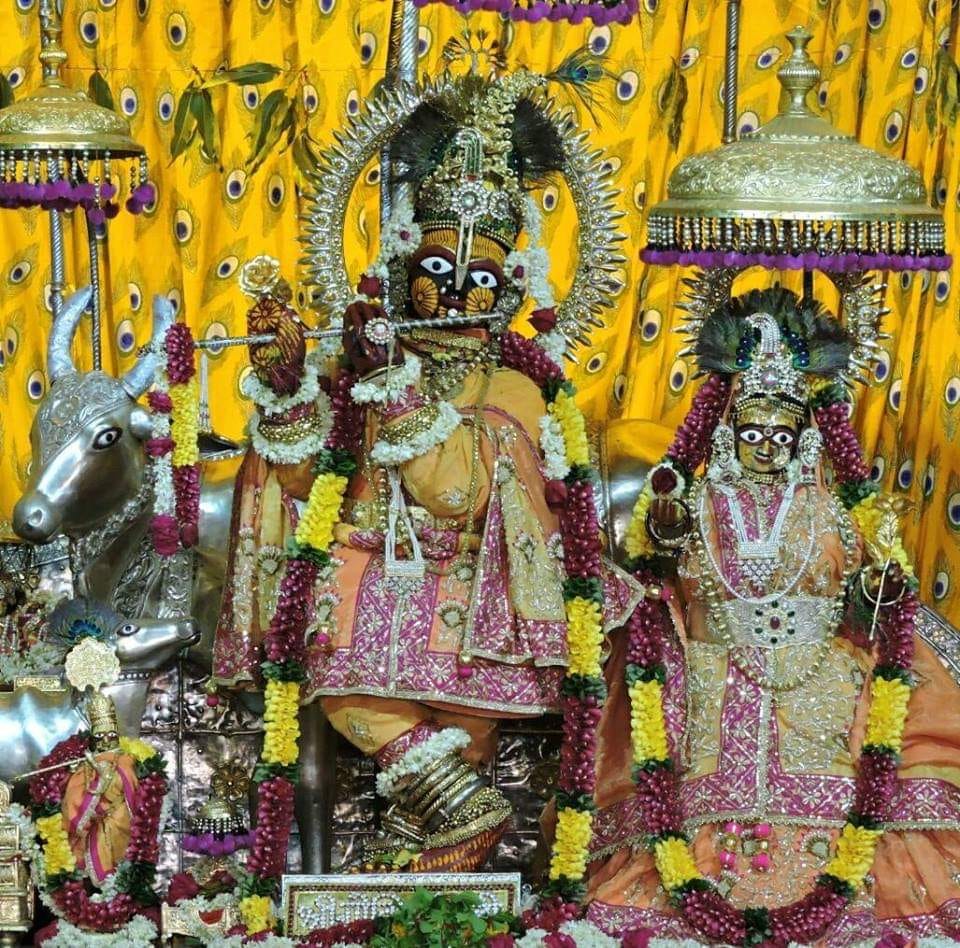
Of the many stories about Govind Dev, His meeting with Shri Radha is most endearing. The son of Odisha’s king, Purushottama was a devout Vaishnava like his father. When he came to know that Vrindavan’s Thakur Madangopal and Govind Dev are shriviheen (without Their Shakti Shri Radha), he sent two beautiful metal vigrahas of Radha to be instated by Their side. However, while the vigrahas were about to reach Dham, Thakur Madangopal appeared to His sevadhikari (servitor) in a dream and said, “Of the two murtis, only one is Radha, while the other one is Lalita. Bring Them both here, and install the smaller one Radhika to my left and the bigger one i.e. Lalita to the right.” His instructions were followed.
Back in Odisha, Purushottama kept worrying about finding Govind Dev’s Radha, until one day when the supreme goddess conveyed Her will to him in a dream. She said, “I have been residing in Chakrabed near Puri for a long time now. People call me Lakshmi. They don’t know that I am Radha. Arrange for my meeting with Govind Dev at the earliest.” Purushottama did as instructed. On reaching Vrindavan, She was consecrated to left of Govind Dev in a grand ceremony which is described in Shri Rupa Goswami’s famous composition ‘Chatupushpanjali’. This was the year 1553 (17 years after Govind Dev’s appearance). The great Goswami entered nitya-lila shortly after that.
As per ‘Saadhan Dipika’, in the past, this vigraha of Radharani had travelled from Vrindavan to Radhanagar in Utkal Desh. There She accepted the loving services of the Brahmin Brihadbhanu as his daughter. She was later established in Chakrabed in accordance with Her wish, which She made known to the King of Puri in yet another dream!
However, it is also believed that the Shri Chaitanya Mahaprabhu had the murti made and sent to Vrindavan along with Kashishwar.
PART – II
Poetry in Stone: the architectural masterpiece
When the old temple built by one of Raghunath Bhatta Goswami’s pupils wore out, he motivated Raja Maan Singh who was a general in the court of Akbar, and one of the King’s nine gems, to build a new one. Shri Raghunath Bhatta Goswami was the younger associate of Shri Rupa and Sanatana Goswami. According to Shri Chiatnya Charitamrita (Antya 13.131), he was the spiritual master of Raja Maan Singh.
The plan for construction of the grand Govind Dev Mandir was conceived around the year 1565 A.D. according to various accounts. At that time, the red sandstone from east Rajasthan was being used by Emperor Akbar for the construction of Agra Fort. Raja Maan Singh being his general and confidant was able to convince Akbar to donate the coveted sandstone – otherwise reserved for imperial palaces/forts – along with 130 ‘bighas’ of land in the service of the King of Vrindavan, Shri Govind Dev. Expenses for building the temple were borne by Maan Singh.
In his monumental work ‘Mathura- A District Memoir’, collector and the district magistrate of Mathura (1871-77) F.S. Growse records an inscription taken from the exterior of the ‘north-west chapel’ which translates as follows…
In the 34th year of the era inaugurated by the reign of the Emperor Akbar, Shri Maharaj Maan Singh Deva, son of Maharaj Bhagwan Das, of the family of Maharaj Prithiraj (of Kurm Kul), founded, at the holy station of Brinda-ban, this temple of Gobind Deva. The head of the works, Kalyan Das, the assistant superintendent, Manik Chand Chopar, the architect Gobind Das of Delhi, the mason, Gorakh Das.
Growse further writes, “Under one of the niches of the west end of the nave is a tablet with a long Sanskrit inscription. This has unfortunately been too much mutilated to allow of transcription, but so much of it as can be deciphered records the fact that the temple was built in ‘sambat’ 1647 i.e A.D. 1590 under the direction of the two Gurus, Rupa and Sanatana.” The fact is corroborated by Margaret H. Case’s ‘Govinddeva: A Dialogue in Stone’, which states that the temple opened in 1590 A.D. However, Case notes it was the 37th year of Akbar’s reign.
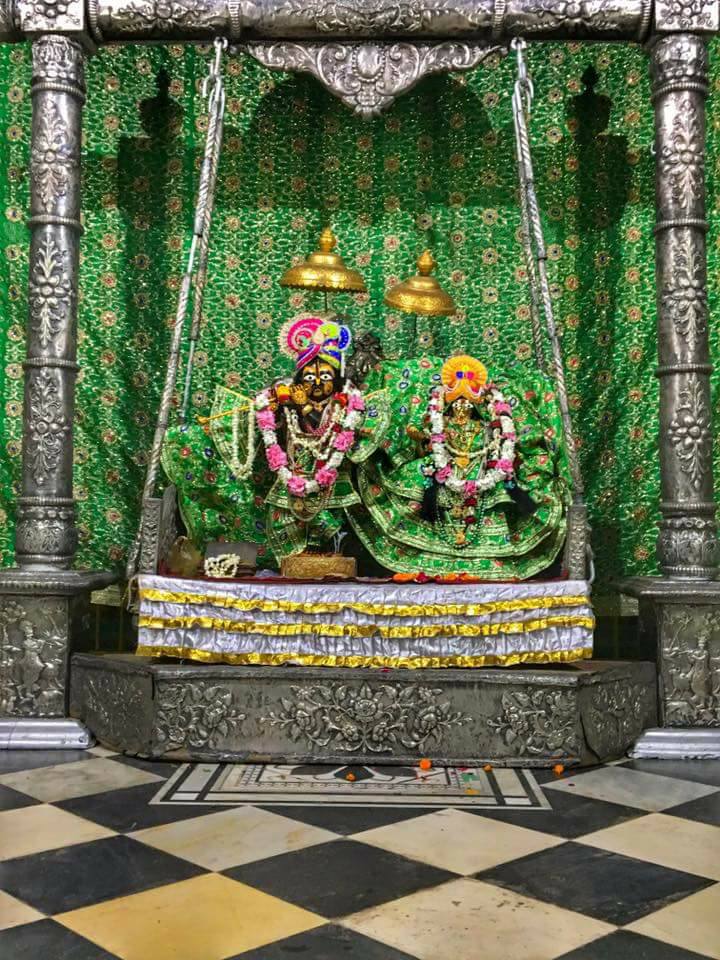
It took nearly 12 years for the temple to come up in its full glory depicted in the unique synthesis of Nagara and Indo-Islamic styles, while following the classical ‘ratha’ layout of Hindu temple architecture. The ‘shri vigraha’ of Thakur Govind Devji Maharaj was consecrated in the shrine under the sole ‘seva’ of Shri Haridas Goswami – second in the line of sevadhikaris.
For more than a century after Raja Maan Singh’s death in 1614 A.D. Shri Govind Deva gave darshan to His devotees in the magnificent temple. In addition to being an architectural marvel, the historical significance of Govind Dev Mandir can be gauged by the fact that it was perhaps the only grand Hindu temple built in northern India during the 600-700 years of iconoclastic Islamic rule. According to Case, the original structure (described as pyramidal) was topped by hundreds of domes and it towered seven grand storeys in height. So tall in fact was the temple that a sacrificial fire in the upper storey, which was fed by 150kgs of ghee daily, was visible from Agra.
However, its unrivalled majesty became an eyesore for the tyrant Aurangzeb, the great grandson of the same Mughal Emeperor (Akbar) who played a pivotal role in its construction. In the year 1670 Aurangzeb ordered his generals to dismantle it block-by-block thereby reducing the most beautiful temple in India to its present size.
The upper storeys completely obliterated, what stands today is the huge, cruciform ‘Mahamandap’. The remaining monument, however, has an elevation that is equal to several storeys in its own right, containing open arcades and a vaulted dome composed of intersecting, pointed arches. In design, the temple, with its accentuated angles and openings, can still be glorified as an innovation in the field of temple architecture.
In this regard, Case writes, “Although the Govindji temple has been subjected to so much senseless havoc, the unique architecture is still praiseworthy. With its ten-foot-thick walls it is considered to be north India’s greatest contribution to temple design.”
Growse went on to aptly describe it as “the most impressive edifice that Hindu art has ever produced, at least in upper India”. According to him the “most characteristic feature of Govind Dev Mandir that went unnoticed by all architects who described this famous building is the ‘harmonious combination of dome and spire’ which is still quoted as the great crux of modern art, though nearly 300 years ago the difficulty was solved by the Hindus with characteristic grace and ingenuity.”
Flight of the Deities: Jaipur via Kamyavan and Radhakund
Anticipating an attack by the iconoclast Aurangzeb, the Lordships were briefly instated at Kamyavan in 1669 A.D., and Their protection was entrusted to Raja Ram Singh (I). From there They were taken to Govindpura in 1707, and later to Amber (Amer) – the old capital of Jaipur – in 1714. They are also believed to have spent some time in Radhakund (Govardhan).
When Sawai Jai Singh (II) established the city of Jaipur, the deities were consecrated in a temple within the precincts of ‘Jai Nivas’ in 1717 A.D. The King was a devout Vaishnava. He got the ‘Chandaramahal’ built in a way that would allow him darshan of Govind Dev from his chamber. Sawai Jai Singh considered himself a servant of Govind Dev, running the kingdom of the His behalf. The official seal of Jaipur state under him carried the following inscription, ‘महाराजाधिराज श्री श्री गोविन्ददेव जी, दीवान महाराजा जयसिंह’…
The King of Vrindavan has been blessing devotees outside the physical boundaries of Shri Dham since then. On His left is Shrimati Radharani, while Mahaprabhu’s Gaur-Govind adorns His right.
PART – III
Resurrecting the phoenix: Shri Govind Mahatmya
Around the time of the reign of Delhi’s Emperor Mohammad Shah (1726-1748 A.D.), the stranglehold of the tyrannical Islamic rule in India had started to loosen. Back in Vrindavan, devotees made a replica of their beloved deities and installed Them in a small temple near the original one. In 1819-20 A.D, following the order of his late Guru Shri Baldev Vidyabhushan, Kolkata’s Nand Kumar Basu commissioned a new temple to the north-west of the old sandstone edifice for the Divinities.
But Vrindavan’s King had by then become the ‘nagara devata’ of Jaipur and the ‘ishta’ of its people who had loved and served Him for nearly two centuries by then. Like many other deities who left Braj-Vrindavan under the ‘pretext’ of escaping the marauding Mughals, Govind was never returned. Till date he remains the ‘bone of contention’ between the two regions – Braj-Vrindavan and Mewar/Rajputana – with each asserting its claim on Him.
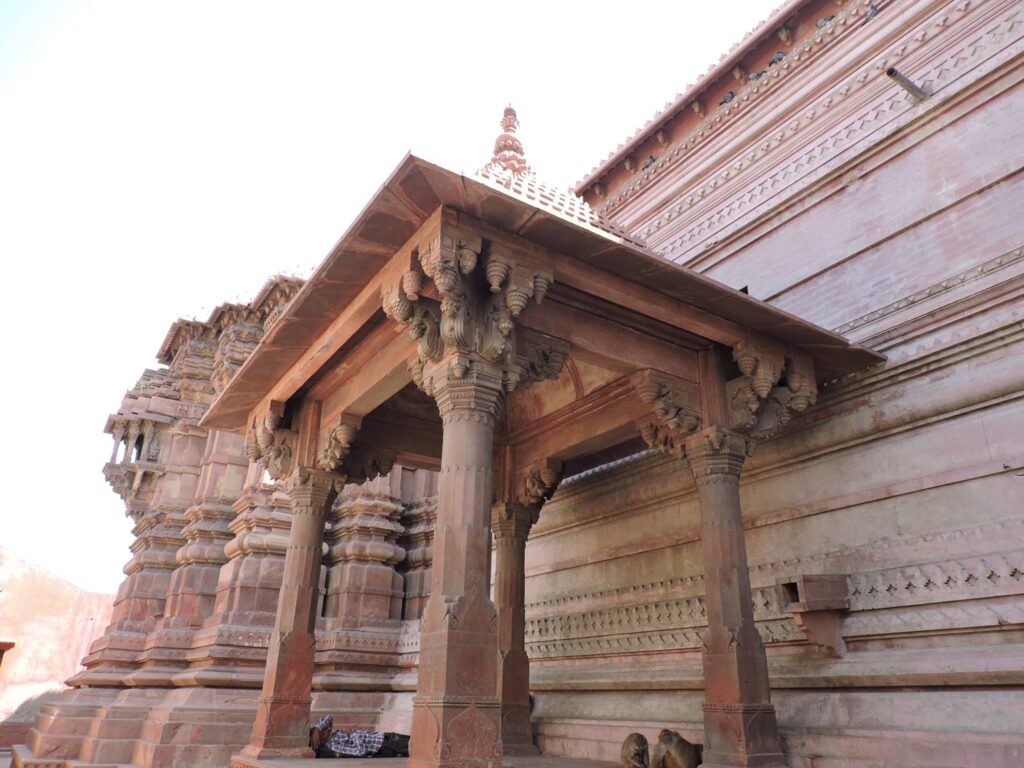
But when has Govind – the heartless enchanter – been known to look back? Then what does one make of His words and His promises?
Why does he lament to Uddhav, ‘ऊधो, मोहिं ब्रज बिसरत नाहीं’…
Why does he in the Bhagavatam promise the Gopis, ‘वृन्दावनम् परित्यज्य पादमेकम न गच्छति’?
The Lord of Vrindavan is not limited by time, space and form. Vrindavan and the Gomatila Yogpeetha is that eternal ocean of nectar which nourishes the souls of devotees everywhere, and every drop emanating from this fountainhead of bliss is the ocean itself. By His causeless mercy Govind assumes a form (‘maunmudra’ or ‘vigraharoop’) to bless devotees elsewhere, but He is forever present in Vrindavan (Gomatila) as His unmanifest essence or ‘tattva’.
The following verse from Gopala Tapani Upanishad (Atharva Ved) explains this esoteric lila of the Lord thus…
गोकुलाख्ये मथुरामण्डले वृन्दावनमध्ये सहस्रदलपद्मे षोड़शदलमध्ये अष्टदलकेशरे गोविन्दोऽपि श्यामः पीताम्बरो
द्विभुजो मयूरपुच्छशिरा वेणुवेत्रहस्तो निर्गुणः सगुणो निराकारः साकारो निरीहः सचेष्टो विराजत इति
In the center of Gokul-Mathuramandal is the thousand-petal lotus of Vrindavan, in whose center is a sixteen-petal lotus which in turn encircles the eight-petal lotus that is the abode of the dark, yellow-robed Govind Deva, who has two hands, He sports the peacock feather and flute, is both with and without attributes and form, devoid of any apparent action, yet ever-engaged in lilas…
Extolling the greatness of Vrindavan’s Govind Peeth in the Varah Trantra, Bhagwan Varaha says,
श्रीवराह उवाच-
कर्णिका तन्महद्धाम गोविन्दस्थानमव्ययम्।
तत्रोपरि स्वर्गपीठं मणिमण्डपमण्डितम्।।
The jewelled lotus in the heart of Yogpeeth is Shri Govind Dev’s dazzling and imperishable abode. At the top of the lotus is a brilliant gem-studded, golden throne…
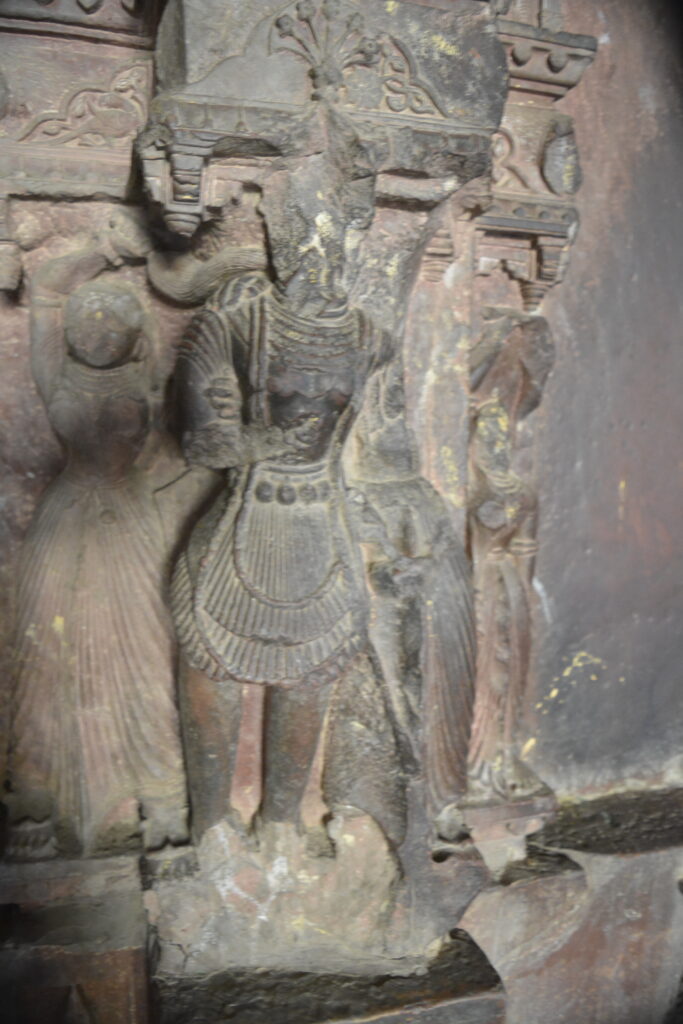
Further it is said,
कर्णिकायां महालीला तल्लीलारसवद्गिरौ।
यत्र कृष्णो नित्य वृन्दा-काननस्य पतिर्भवेत्।।
कृष्णो गोविन्दतां प्राप्तः किमन्यैर्बहुभाषितैः।
दलं तृतीयकं रम्यं सर्वश्रेष्ठोत्तमोत्तमम्।।
In the soft petals of that lotus, Shri Krishna performs His Rasalila. How can the glory of that hillock be described where the eternal King of Vrindavan became Govind’ (attained Gopalatva). The tender and beautiful third petal of that lotus is supreme among all things coveted…
(The name Govind itself is extraordinary for it places Krishna in the center of Goloka Vrindavan as the enjoyer and the source of all enjoyment, the darling of all Gopis (Gopijan Vallabha) who carefully protect, nurture and direct their ‘Go’ – the senses – towards Him.)
Similar references about the significance of Vrindavan’s Gomatila as not just the ‘prakatya’ (appearance), but also the ‘nitya (eternal) sthali’ of Govind Dev are found in other Puranas, Upanishads, Tantras and other shastras such as Sammohanaa tantra, Skanda Puran (Mathura Khanda), Brahmavaivarta Puran, Padma Puran (Vrindavan Mahatmya), Adivarah Purana and Shri Govindlilamrita.
They indisputably establish the fact that Govind Dev is the unrivalled King of Vrindavan, and that His supreme ‘lilasthali’ is the lotus-shaped Yogpeetha of Gomatila. He commands the same status in Vrindavan as Dwarakadheesh does in Dwaraka, Jagannath in Odisha, Mahakaal in Ujjain and Vishwanath in Kashi.
It was on the basis of these shastric directions/revelations that Shri Rupa Goswami set out to discover Him. Sripad Ramdas Babaji Maharaj, one of the greatest mystic Gaudiya acharya in recent times never went to see the Govind at Jaipur for this reason. In olden days it was customary for pilgrims to visit Govind with ‘dusty feet’ and pay homage to Him on arrival in Vrindavan. This tradition is still followed by many Vaishnava babajis.
However, the shastras and Krishna’s promise to the Gopis notwithstanding, the weakened material and spiritual faculties in this age of confusion and darkness need a form to fix the manas-buddhi-chitta on. Hence the merciful Lord acquiesces to become the devotee’s ‘object of love’, so that he can use his focused energies to turn the consciousness within and eventually find ‘Govind’ sporting in the ‘ashtadalkamal’ (eight-petal Lotus) of his own eternal and pristine ‘hridi vrindavan’.
This explains why the King of Vrindavan and His divine abode have been relegated to the background in these times, while His manifest form continues to be the heartthrob of Jaipur. The Mughal invasions, the flight of Deities and the refusal Their custodians to return Them (for which petty arguments such as the ‘temple being desecrated’ became the pretext), were all the compassionate ‘lilas’ of Govind; He awaits His devotee who will after enjoying and perfecting the drops come back to the fount…
From a distance, Vrindavan’s majestic Govind Dev Mandir seems quite alluring, but as one ventures near/inside it for the first time, the imposing energies of the Yogpeetha stir up an uncanny fear that overwhelms the devotee for a moment. The fear is not an earthly one, but that of losing the ego that binds us to the ‘samsara’, the ocean of misery. Who, but Govind, is capable of such a feat! He enchants the seeker only to cut off his mortal coils. It is for this reason that Shri Rupa Goswami ‘warned’ people regarding Govind Dev in the Bhaktirasamruta Sindhu…
स्मेरां भंङ्गीत्रय परिचिता साचि विस्तीर्ण दृष्टिं
वंशीन्यस्ताधर किशलयामुज्ज्वलां चन्द्रकेण।
गोविन्दाख्यां हरितनुमितः केशीती्र्थोपकण्ठे
मा प्रेक्षिष्ठास्तव यदि सखे! बन्धुसंगेअस्ति रंगः।। (भ.र.सि.)
O friend! If you wish to enjoy the company of your wife, children, friends and family never have darshan of that Govind residing near Keshi tirtha. Adorned with a peacock feather, a sweet smile, and slanting, large eyes, He stands in ‘tribhang mudra’ (bent in three places, neck, waist and knees) holding the flute to His lotus lips. If you ever see His transcendental form bright as/with the moonshine, you will forget everything else.
If His form is so potent, what can be said about His internal potency! Describing the latter’s glory the Adivaraha Puran categorically states,
वृन्दावने च गोविन्दं ये पश्यन्ति वसुंधरे।
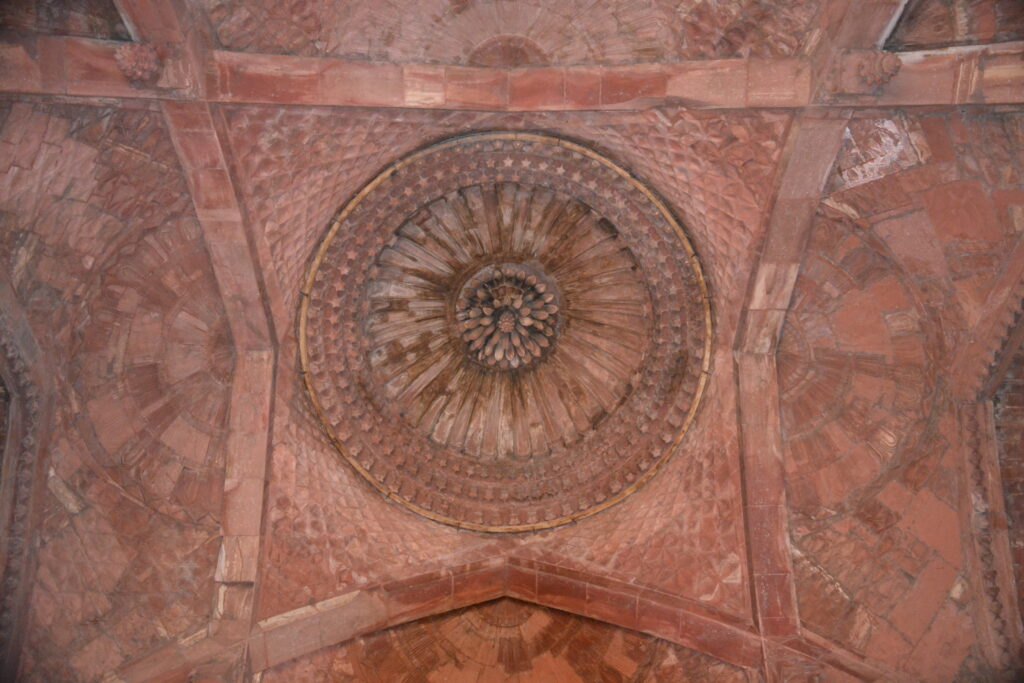
न ते यमपूरं यान्ति यान्ति पुण्यकृतां गतिम्।।
Those who worship/see Govind Dev ‘in Vrindavan’, never go to Yamaloka; they directly attain punyagati…
It is said that only the privileged are allowed in Braj, the more fortunate come to Vrindavan, how much more merit should then one possess to enter the King’s palace, supreme among all Kshetras/Peethas. Yuga after yuga, He manifests from the heart of the jewelled lotus in Govind peetha; He, verily, is the Lord of Vrindavan!


